All art is nothing but the imitation of nature (Seneca)
(To liven up the reading of this post I leave you the link to a short version of the Vivaldi’s four seasons https://www.youtube.com/watch?v=NnygRClLHU4)
Often when we talk about the beauty or size of a place we have visited, we say that they are indescribable. Really we mean that we have been so impressed that it is hard for us to find the words to describe them. When I arrived in Khumbu area in July last year, the fact that it was the monsoon season and the landscape was partially hidden by the clouds made me realize how different it was compared to the other times I had been there.
Something similar happened to me when I arrived in Namche after a couple of days of hiking, almost alone, on the way up from the small airport in Lukla. I suddenly came across a quiet village, where during the tourist seasons there is a bustling village, full of people going up and down.
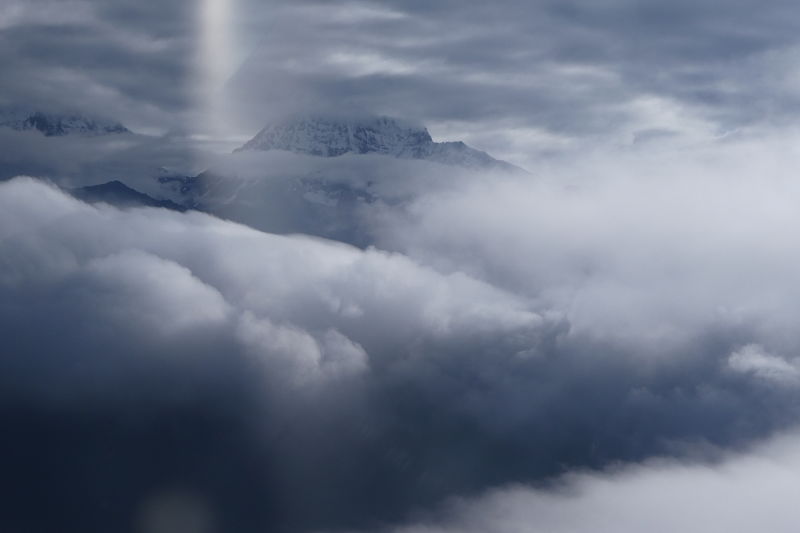
Flying through morning clouds 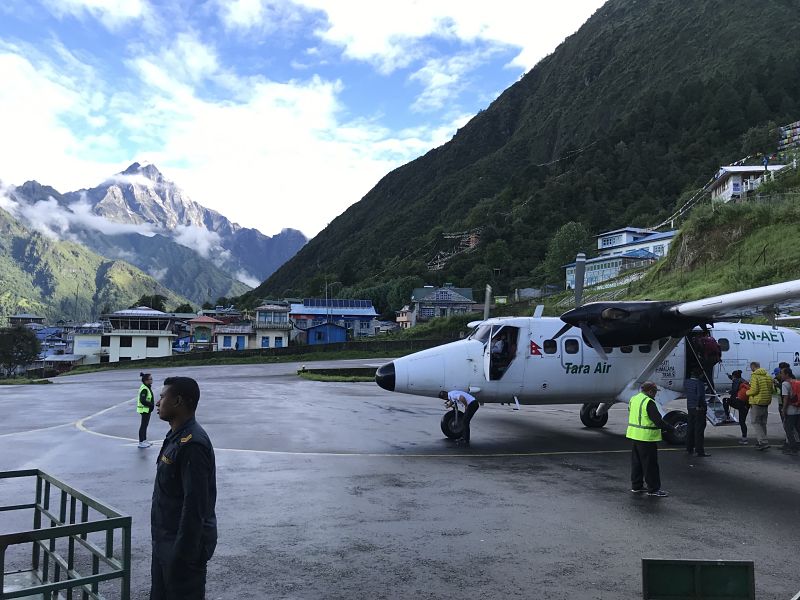
Tenzing – Hillary airport – Lukla
The feelings that these two events provoked in me led me to look for words to describe the changes that the different times of the year produce in the landscape and in the environment and life of Namche. And that’s how, from the beginning, I started writing about the four seasons, and despite missing the spring due to my unexpected early return home, I wanted to finish what I started. This is the result.
Summer
July 29. Lukla. 2/4 of 8 in the morning. After a half-hour flight through morning clouds, I cross the village with wet and empty streets I take the path that in a couple of days will bring me to Namche. I’m alone. I walk without haste. Ideal for observing and thinking.
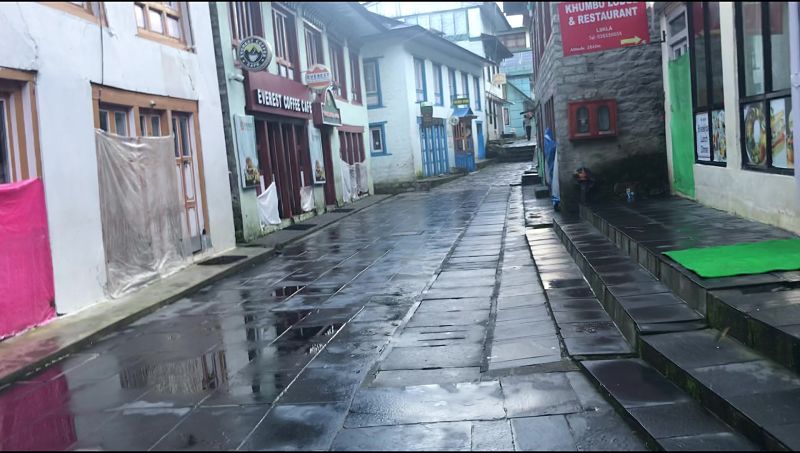
Wet and empty main street in Lukla 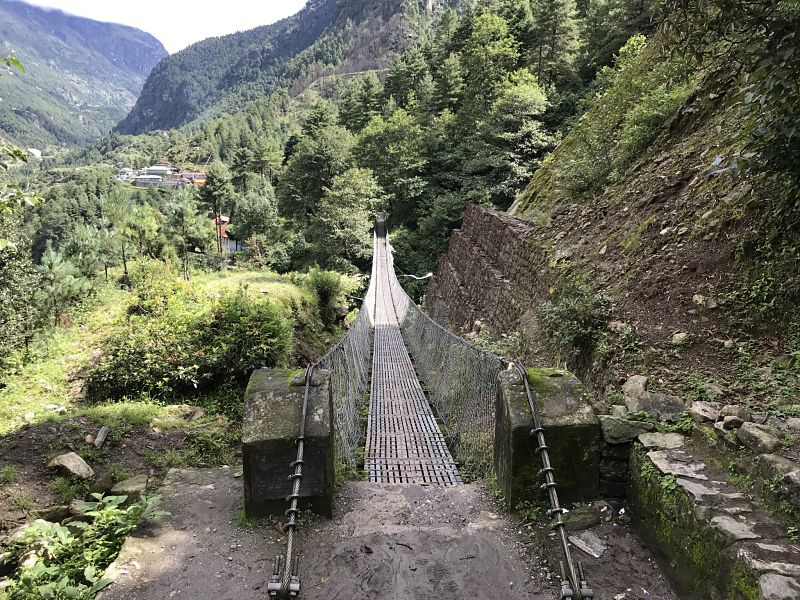
The first hanged bridge without anyone
It is cloudy, no peak is seen. Every time I look up the trail and see what is around me, my eyes fill with intense green. A green that will accompany me all summer wherever I go, as far as the vegetation goes. There are waterfalls everywhere. The rivers flow extremely fast and noisy. All in all, for me, who had only been there in the fall, it is a surprise.
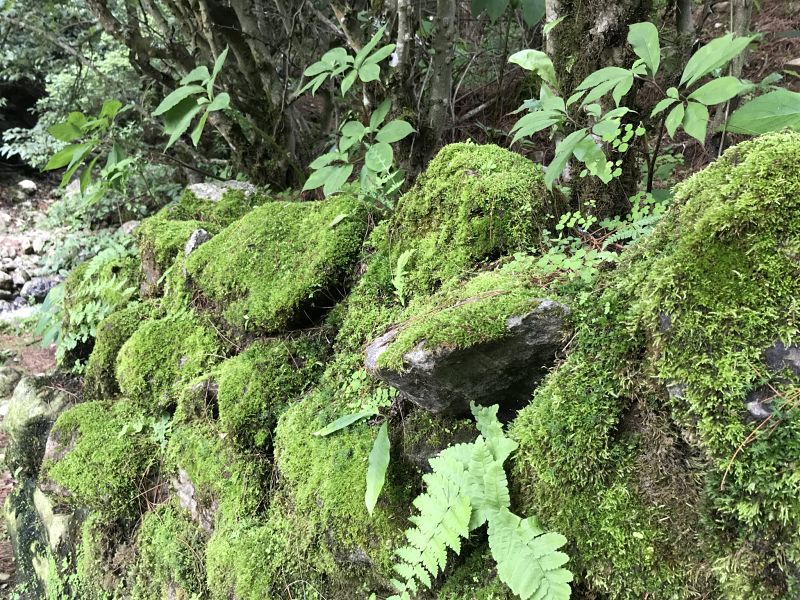
Vivid green 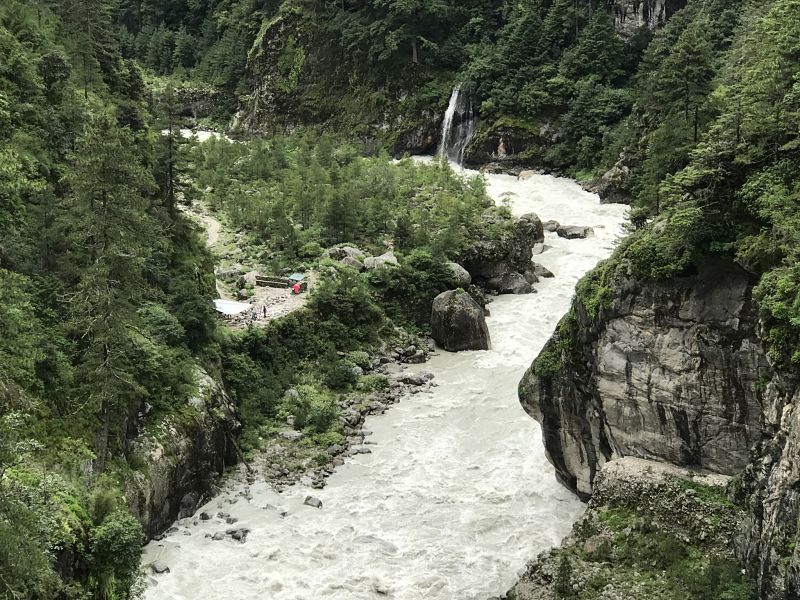
Turbulent waters
Mornings are not raining. It is in the afternoon when rain comes, and a lot. This allows me to reach Namche without opening my umbrella, even enjoying the sun. From what I could see for the rest of the summer, the heavy rains in the second half of the monsoon shifted for a month and a half, ending well into the fall. Another effect of climate change.
Once settled in Namche, the walks through the village revealed to me a different Namche than the one I knew. Very few tourists, only one shop open (luckily there is the weekly market), most hotels, lodges and cafes also closed. Quiet streets, with the people of the village sitting banging and watching the few foreigners we moved through the streets. The feeling of peace and tranquillity, although I expected it, surprised me. It was like living in a village that was off the tourist circuit.
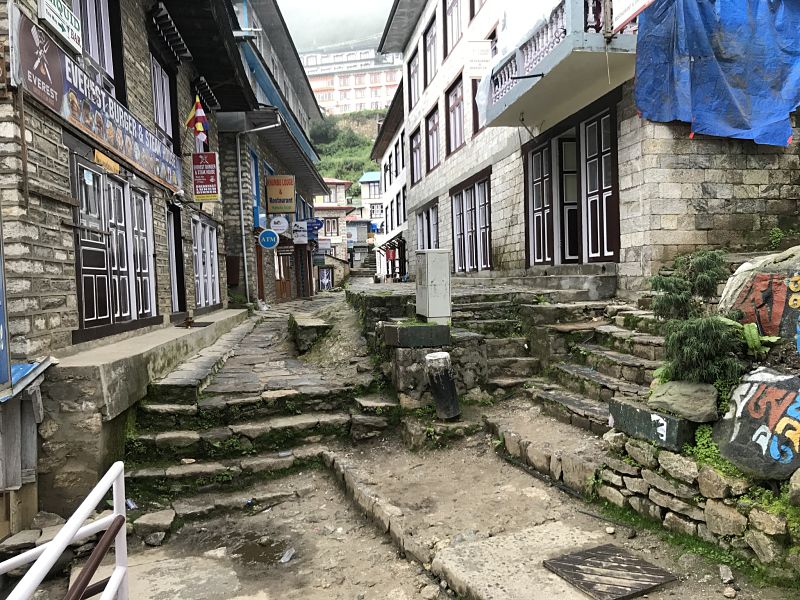
Empty streets in Namche, in summertime 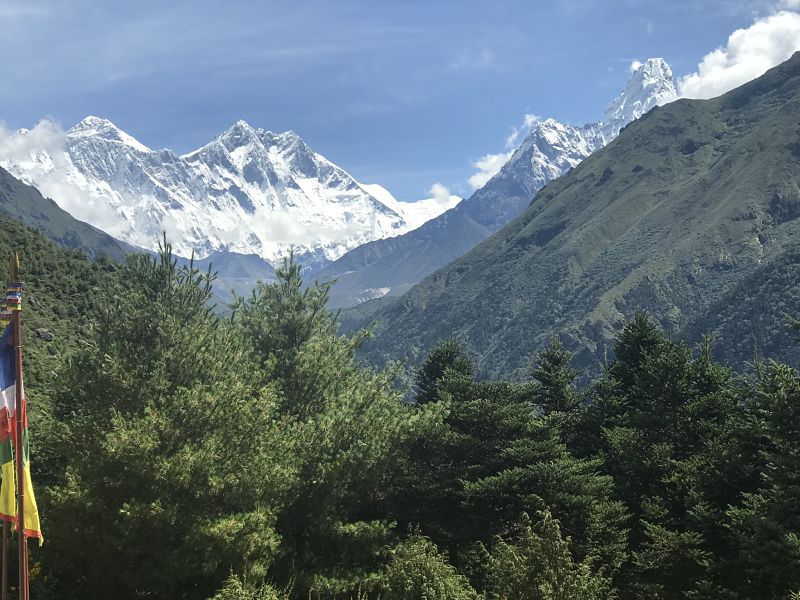
First look from the Namche’s View Point
At the highest part of Namche there is an exceptional belvedere, the View Point. I made it my point of observation of the changes in the landscape all the time I lived there. A place with spectacular views, not only of Everest, but of all the mountains surrounding the Khumbu valleys. I went up there two or three times a week to document the changes in the landscape.
During the summer months, many days the peaks were hidden by clouds and that was when, even if it was not sunny, the intense green of forests and meadows stood out. A green that, on sunny days, was overshadowed by the sight of the snow-capped mountains.
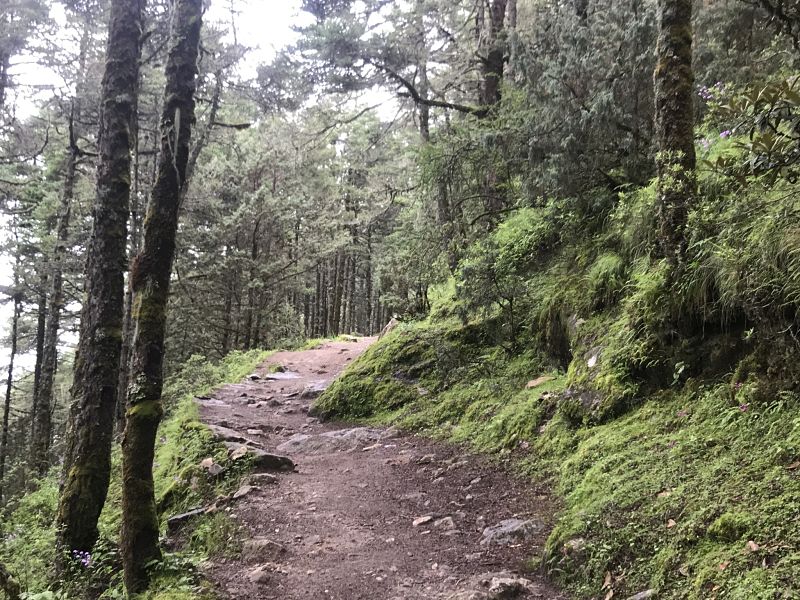
Green forest, in summer season 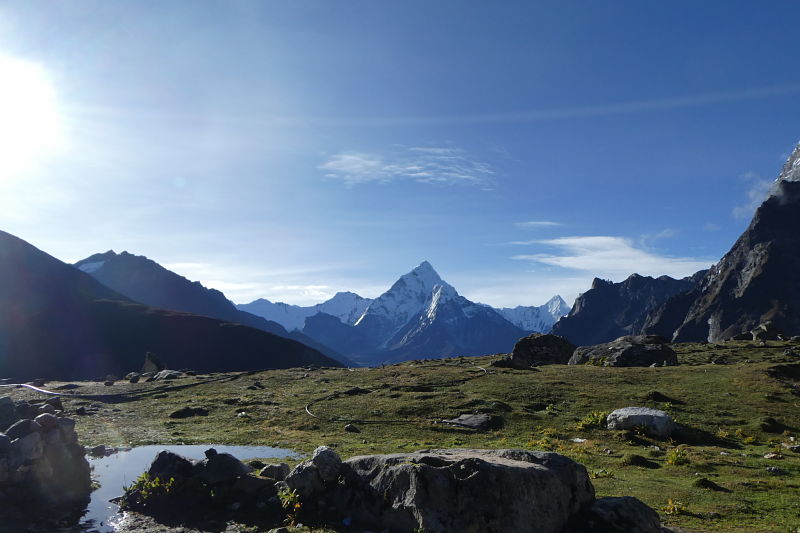
Green meadow with Ama Dablam in the background
There, summer is the time to collect mushrooms. Everyone goes out to look for them, and by the way, they are delicious! Mostly freshly harvested. They dry them in large quantities and have them all winter long, which is when the few vegetables available are usually scarce.
Fall
The delay of the rains greatly affected the beginning of fall and the quintessential tourist season. All the villages and especially Namche suffered the consequences of the late rains. Planes and helicopters could not fly between Kathmandu and Lukla and therefore tourists did not arrive, and reservations were cancelled or dates changed. Until the end of the first fortnight of October the situation did not return to normal and then yes, Namche was invaded by hundreds of tourists filling the streets, shops and accommodation places. The tranquillity was over. It is time for business and the village seems to be transforming.
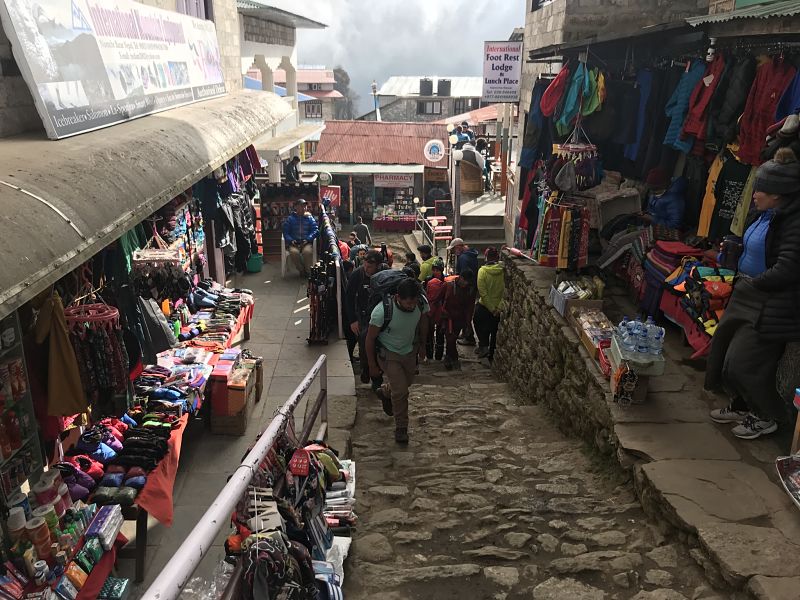
Busy Namche in fall season 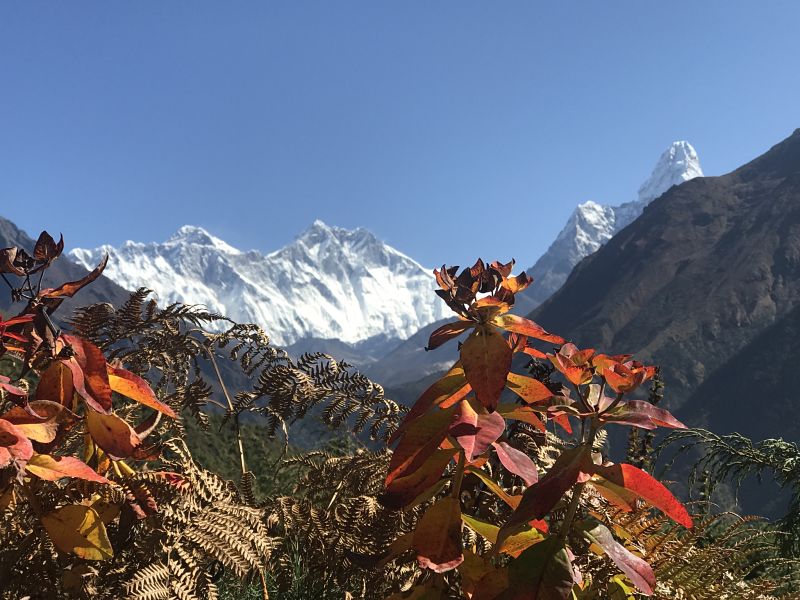
Fall’s Everest panorama
After monsoon rainfall season, the landscape began to change from the green of the grassy meadows to the brown of the dry grass, and from the mud of the paths to the dust, a fine dust that gets everywhere when you walk. But it is also a time of flowers, many flowers. It seemed to me like a springlike fall.
The rivers greatly decreased in flow. I watched as the waterfalls went thinner day by day. By the end of November, they were already starting to freeze. Winter was knocking at the door. Guides and climbers were already waiting for it because that’s when the trekking and expedition season ends, and the climbing schools start the ice training. They don’t have to go very far from home.
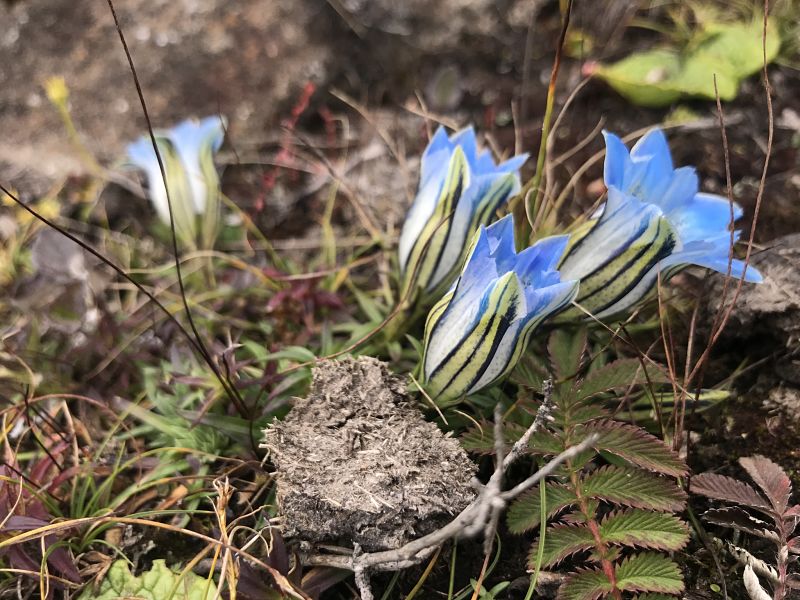
Springlike fall season 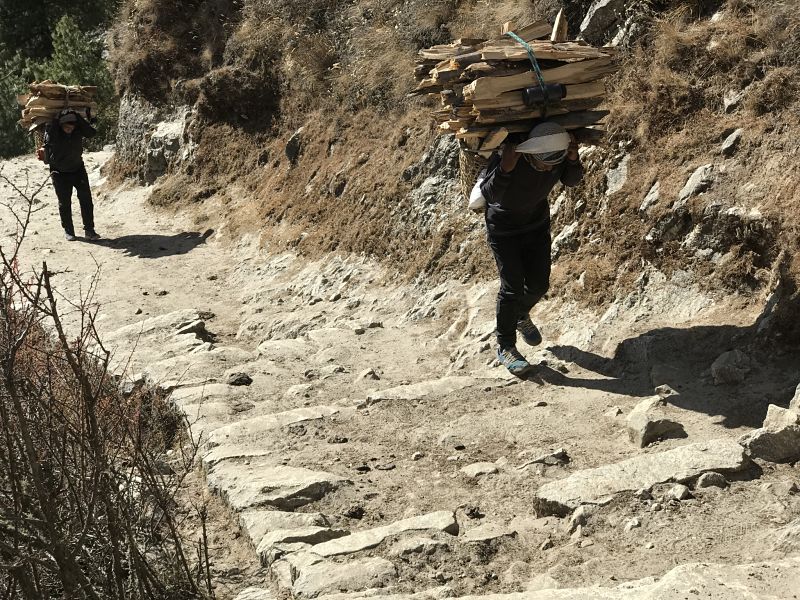
Carrying firewood for the coming winter
Autumn, for the people of the country, is the time to make money and for tourists it is the best time of the year as the weather stabilizes and the days are sunny. Although the nights are getting colder, if it is sunny, it can get hot during the day. I saw many people hiking in a short-sleeved t-shirt early December.
December is also the time to collect dry leaves in the forest to make fertilizer, and to cut firewood. As the trails cleared of tourists, many local people invaded the trails carrying great amounts of firewood. It’s time to prepare for winter is about to come.
Winter
Although it was still a week away from the astronomical winter, I already had a little taste of it going down from Namche to Kharikhola, on my way home for Christmas. The day after leaving Namche, the sky darkened, the fog fell, and the snow fell hard to low altitudes. Namche was left under 50 cm of snow.
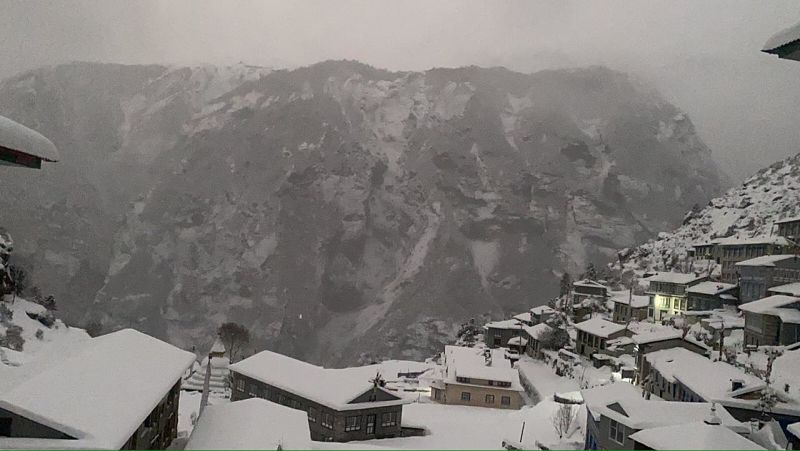
First winter snowfall in Namche 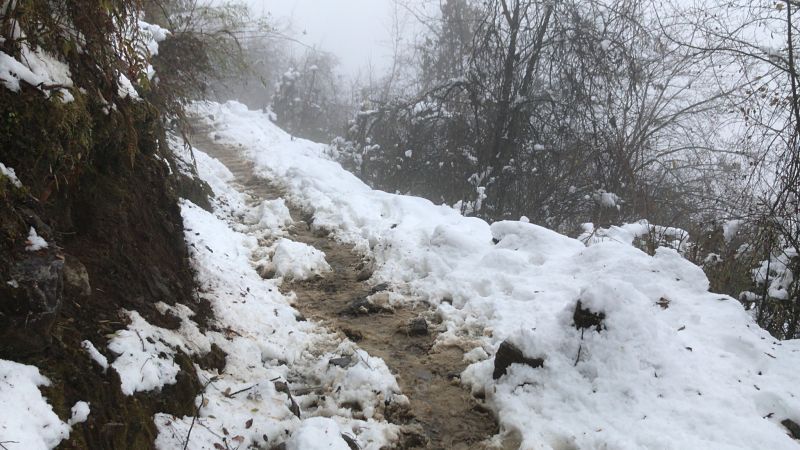
Snow and mud on the way down to Kharikhola
The snow also whitewashed a stretch of trail to Kharikhola. My friend Pasang and I experienced the effects of the snow, especially when it is less than a handful thick, when it mixes with the dust of the trails and the excrement of the hundreds of mules that pass through it. A kind of mud is formed that slips more than if it was fat. Standing, even with the help of poles, is a challenge. On the third day of the way down we arrived at the lodge where we spent the night, very dirty. We had to wash gloves, pants, socks and boots. Thanks to the lodge stove, we stayed clean and dry for the next day.
Although it was not a very snowy and cold winter, at the end of January in Namche there was a snowfall of more than 1 meter thick, which in Thame was more than 2 meters. It was a winter of small snowfalls (10 or 15 cm), very frequent, which, thanks to the force of the insolation at those heights, melted quickly. Of course, where it didn’t melt right away, it would freeze at night and then stay there for many days.
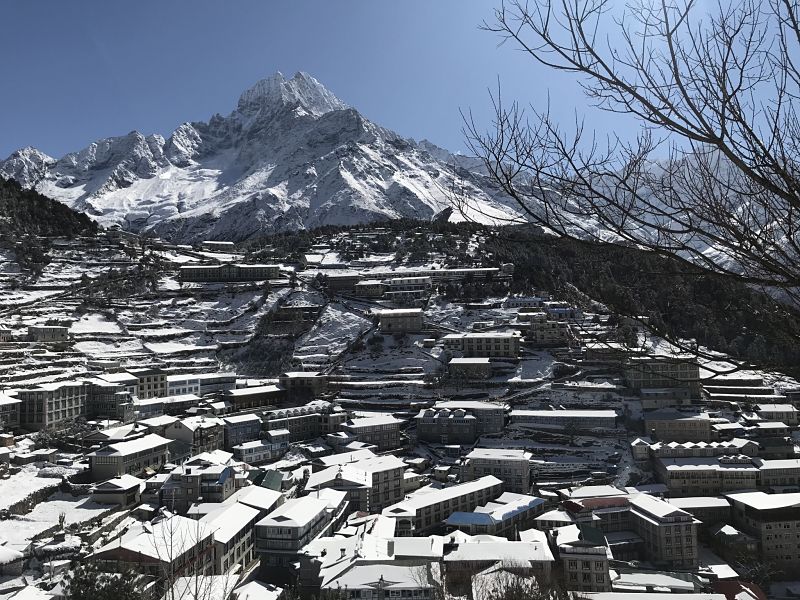
White Namche with Thamserku in the background 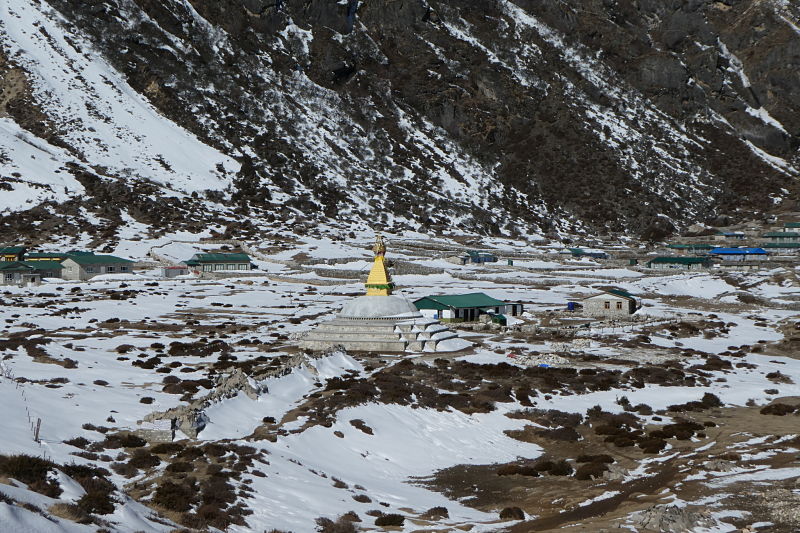
Snowy Thame, et the end of winter season
This winter, in Namche, the minimum temperature “only” was -9.9 ºC. The most common is for the minimum temperature to drop to -20 ºC. However, once there, I was able to see the less visible effect that most affects everyone’s daily life, the icy water pipes. Many of the houses and lodges above 3,000 meters are left without water for two or three months, with the difficulties that this entails. Everyone must to fetch water with drums from one of the village springs or from the river, which rarely freezes. And when that happens, the last resort is to melt snow.
You may be wondering what people do in winter in these conditions. So, those who can, go down to Kathmandu where they do social life. The luckiest ones travel to tourist areas of the country or abroad. It’s also wedding time. Currently most Sherpas weddings are held in Kathmandu. That’s why in the whole time I was up there I couldn’t see any of them.
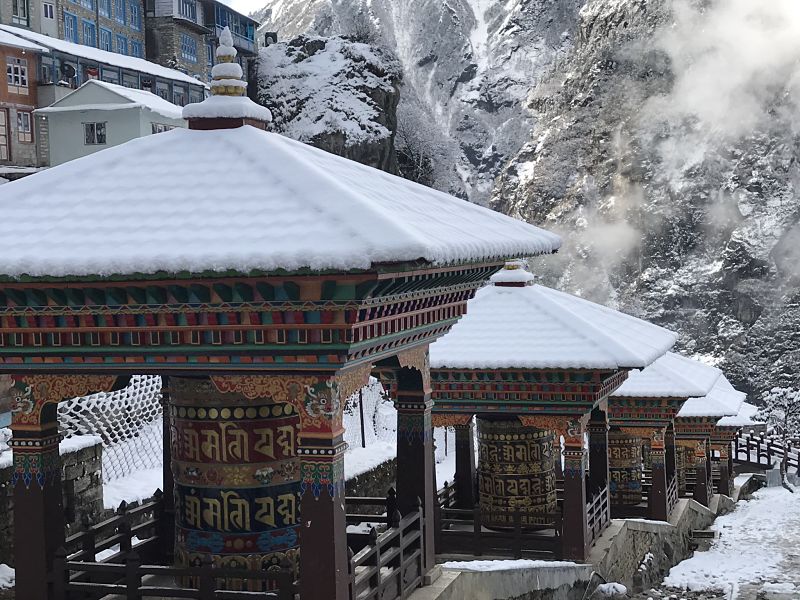
Prayer wheels in Namches’s entrance 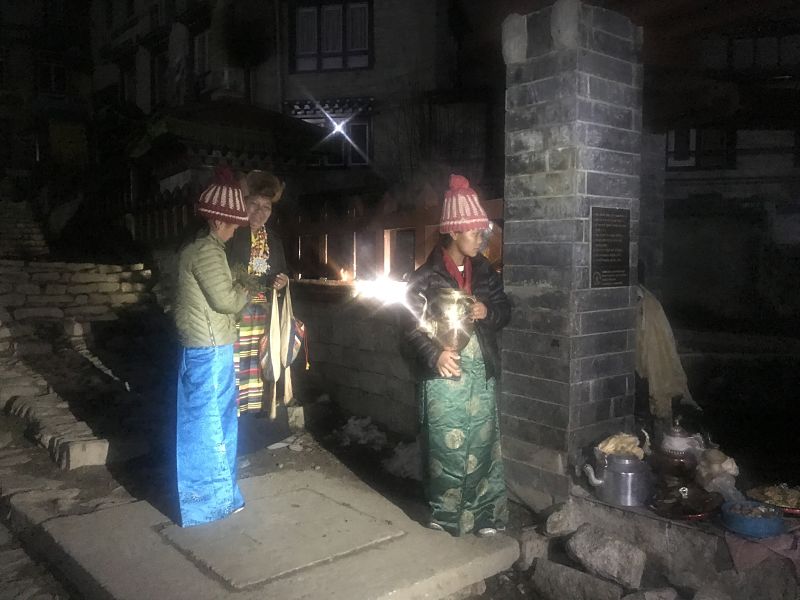
Morning offering for the Sherpa’s New Year’s Day (Gyalpo Losar)
Schools are closed. There are almost no tourists. Lodges and shops are also closed. People, when it is sunny in the sunny corners, chat with each other and because they are very curious, they are always about to give conversation to any foreigner who walks down the street. Towards the end of winter, the Sherpa New Year (Gyalpo Losar) is celebrated, the school opens, tourists begin to arrive for the spring season, and little by little, shops and accommodations begin to open. It’s like getting out of a hibernation.
Spring
This year, in early March, the Nepalese government banned all international flights to Nepal and the flow of tourists, which had begun in late February, came to a halt. The tourist spring season vanished before it began. Take in account that the season of expeditions is the most lucrative business in the region. There were none this year. And the few foreigners we were there, we magically disappeared in a few days.
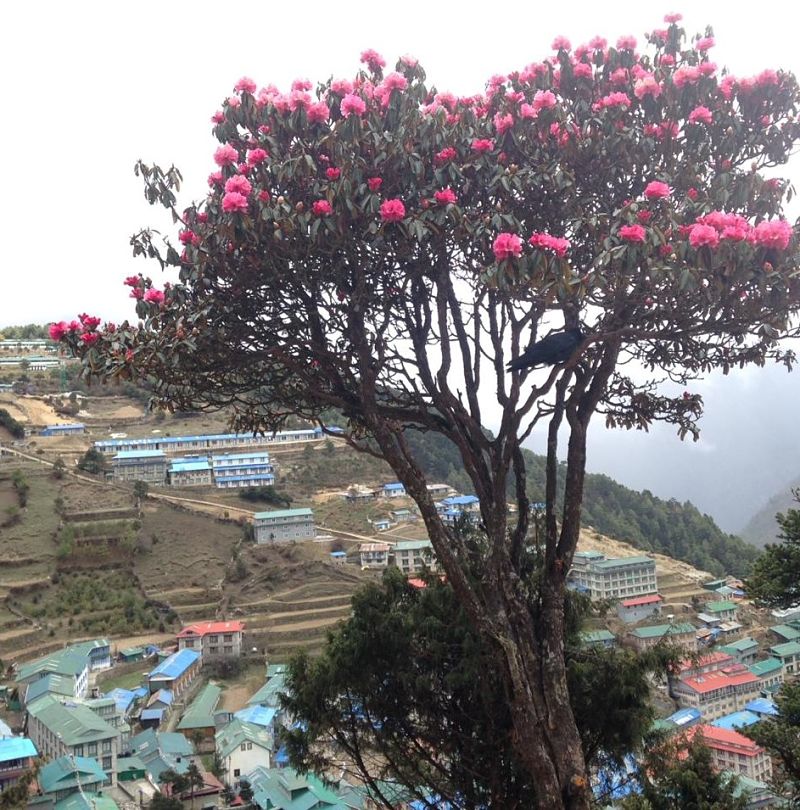
Rhododendron in blossom, spring time in Namche 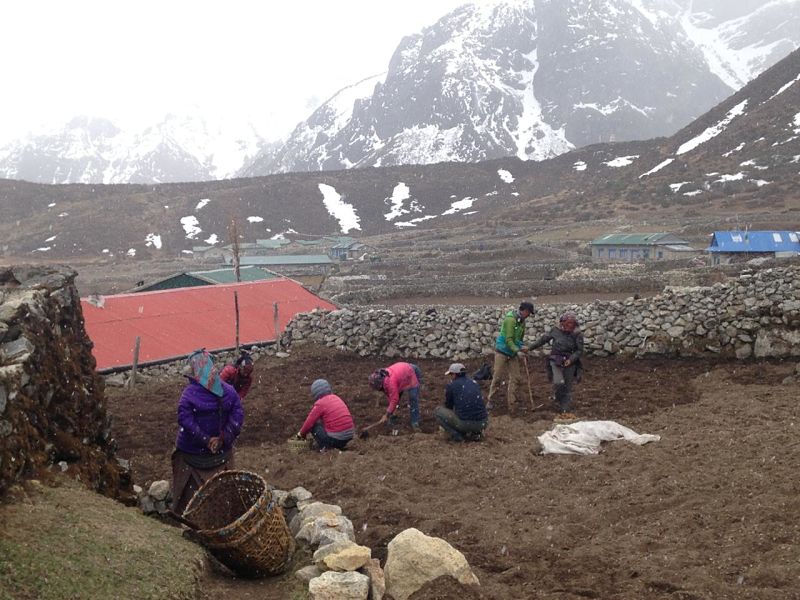
Spring season, time for planting potatoes in Thame
Aside from tourism, spring is the most splendid season of Khumbu. It is the time of flowering but also of planting the potatoes that are the main crop in the area and a staple of their diet, along with rice and lentils.
From what I know, the spring’s bursting is impressive for the wide variety of flowers that grow everywhere and the flowering of the trees. Especially the rhododendron (rhododendron arboreum) which in Nepal are very tall trees. Its pink flower is the symbol of Nepal. In Khumbu there are vast forests of rhododendrons, which live up to 4,000 m.
The “spring” photos I add to this text are the ones my friend Pasang sent me. I hope that soon I will be able to come back there and enjoy the spring of Khumbu personally, and share it with all of you.
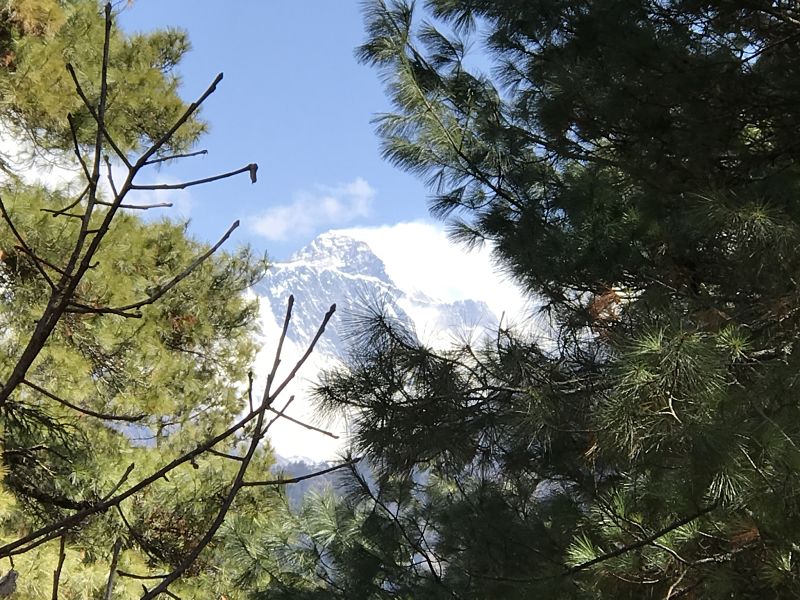
As you have seen, an experience, the mine, that had to last four seasons, like Vivaldi’s concert, which has finally lasted three, but lived with intensity.